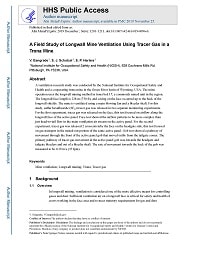Mining Publication: A Field Study of Longwall Mine Ventilation Using Tracer Gas in a Trona Mine
Original creation date: December 2019
Authors: V Gangrade, S Schatzel, S Harteis
A ventilation research study was conducted by the National Institute for Occupational Safety and Health and a cooperating trona mine in the Green River basin of Wyoming, USA. The mine operation uses the longwall mining method in trona bed 17, a commonly mined unit in the region. The longwall face length is 228 m (750 ft), and caving on the face occurred up to the back of the longwall shields. The mine is ventilated using a main blowing fan and a bleeder shaft. For this study, sulfur hexafluoride (SF6) tracer gas was released in two separate monitoring experiments. For the first experiment, tracer gas was released on the face, this test focused on airflow along the longwall face of the active panel. Face test showed the airflow patterns to be more complex than just head-to-tail flow in the main ventilation air stream on the active panel. For the second experiment, tracer gas was released two crosscuts inby the face on the headgate side, this test focused on gas transport in the mined-out portion of the same active panel. Gob test showed a pathway of movement through the front of the active panel gob that moved outby from the tailgate corner. The primary pathway of tracer gas movement in the active panel gob was towards the headgate and tailgate bleeders and out of a bleeder shaft. The rate of movement towards the back of the gob was measured to be 0.19 m/s (37 fpm).

- CO and CO2 Emissions from Spontaneous Heating of Coal Under Different Ventilation Rates
- Experimental and Modeling Investigation of the Effect of Ventilation on Smoke Rollback in a Mine Entry
- Investigation into the Practical Use of Belt Air at US Longwall Operations
- Maximizing the Ventilation of Large-Opening Mines
- Methods to Improve Mine Ventilation System Efficiency
- Novel Stopping Designs for Large-Opening Metal/Nonmetal Mines
- Sulfur Hexafluoride as a Mine Ventilation Research Tool - Recent Field Applications
- Technology News 519 - EZ-Up Curtain Stoppings: A Practical Solution for Directing Ventilation Airflows in Large-opening Metal/Nonmetal Mines
- Use of Vertical Boreholes for Assisting Ventilation of Longwall Gob Areas
- Using Ultrasonic Anemometers to Evaluate Face Ventilation Conditions